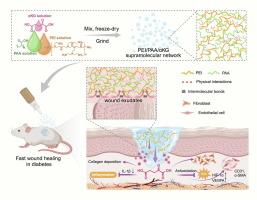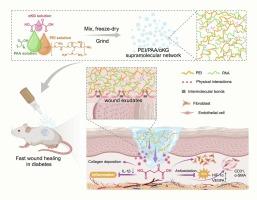α-酮戊二酸超分子网络通过管理渗出物和新生血管加速糖尿病伤口愈合
IF 13.3
1区 工程技术
Q1 ENGINEERING, CHEMICAL
引用次数: 0
摘要
糖尿病足溃疡等慢性伤口的愈合是一项严峻的临床挑战,因为大多数传统的伤口敷料都无法解决渗出物过多、持续炎症反应和血管微循环障碍等问题。为了促进糖尿病病理环境下的伤口愈合,本研究开发了一种具有生物活性和代谢性 αKG 的超分子网络--聚乙烯亚胺/聚丙烯酸/α-酮戊二酸(PEI/PAA/αKG),用于渗出物管理和血管微循环重建。PEI/PAA/αKG 超分子粉末一旦沉积到伤口部位,就会迅速吸附渗出物并在原位凝胶,从而形成一道坚固的保护屏障,在伤口愈合过程中持续管理伤口渗出物。由于网络中存在可逆的氢键和静电相互作用,生物活性αKG单体可根据pH值从超分子网络中解离,从而促进慢性糖尿病伤口的愈合。在 PEI/PAA/αKG 超分子水凝胶的介导下,愈合伤口的胶原沉积、软组织再生和新生血管形成均得到明显改善。研究进一步证实,PEI/PAA/αKG 在糖尿病条件下对血管生成的显著效果来自于αKG 对细胞氧化应激的调节作用。本发明的治疗分子材料化方法为解决生物医学应用中的代谢分子问题提供了一种潜在的策略。本文章由计算机程序翻译,如有差异,请以英文原文为准。


Alpha-ketoglutarate supramolecular network accelerates diabetic wound healing through exudates management and neovascularization
Healing of chronic wounds such as diabetic foot ulcers is a critical clinical challenge due to the failure management of excess exudates, persistent inflammatory responses, and vascular microcirculatory disturbances by most traditional wound dressings. To promote the wound healing under diabetic pathological environment, a supramolecular network, polyethyleneimine/polyacrylic acid/alpha-ketoglutarate (PEI/PAA/αKG) with bioactive and metabolic αKG was developed herein for exudates management and vascular microcirculatory reconstruction. Once deposited onto the wound area, the PEI/PAA/αKG supramolecular powder would quickly adsorb the exudates and in-situ gel to form a robust protective barrier for sustainably managing the wound exudates during the healing process. Owing to the reversible H-bonding and electrostatic interactions in the network, bioactive αKG monomer could responsively dissociate from the supramolecular network in a pH-dependent manner to promote the chronic diabetic wound healing. The collagen deposition, soft tissue regeneration, and neovascularization of the healing wound were all obviously enhanced under the mediation of PEI/PAA/αKG supramolecular hydrogel. It was further confirmed that the outstanding effect of PEI/PAA/αKG on angiogenesis under diabetic condition results from the function of αKG on cellular oxidative stress regulation. The present method of materializing therapeutic molecules provides a potential strategy to solve the problem of metabolic molecules in biomedical application.
求助全文
通过发布文献求助,成功后即可免费获取论文全文。
去求助
来源期刊

Chemical Engineering Journal
工程技术-工程:化工
CiteScore
21.70
自引率
9.30%
发文量
6781
审稿时长
2.4 months
期刊介绍:
The Chemical Engineering Journal is an international research journal that invites contributions of original and novel fundamental research. It aims to provide an international platform for presenting original fundamental research, interpretative reviews, and discussions on new developments in chemical engineering. The journal welcomes papers that describe novel theory and its practical application, as well as those that demonstrate the transfer of techniques from other disciplines. It also welcomes reports on carefully conducted experimental work that is soundly interpreted. The main focus of the journal is on original and rigorous research results that have broad significance. The Catalysis section within the Chemical Engineering Journal focuses specifically on Experimental and Theoretical studies in the fields of heterogeneous catalysis, molecular catalysis, and biocatalysis. These studies have industrial impact on various sectors such as chemicals, energy, materials, foods, healthcare, and environmental protection.
 求助内容:
求助内容: 应助结果提醒方式:
应助结果提醒方式:


